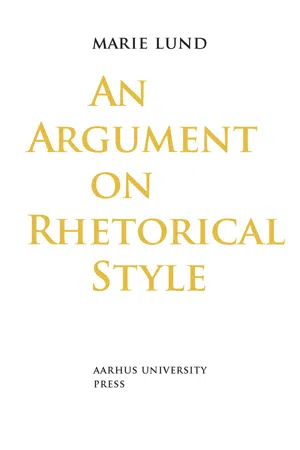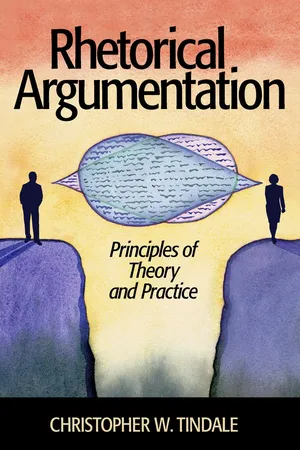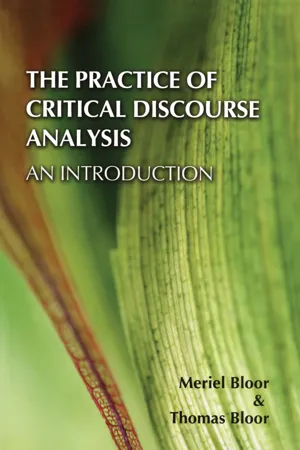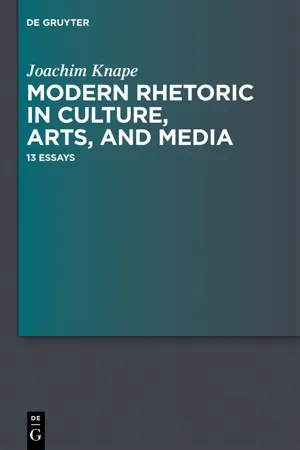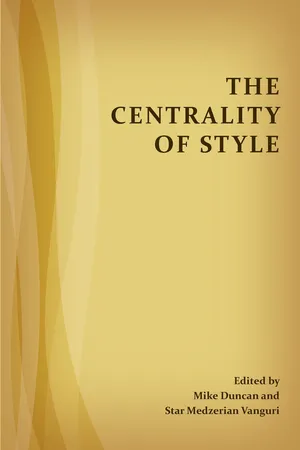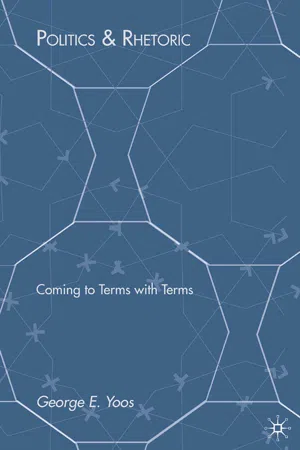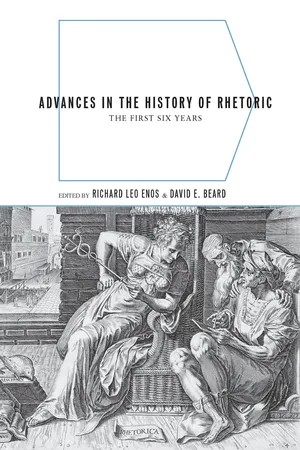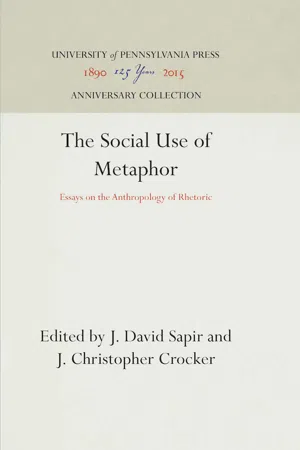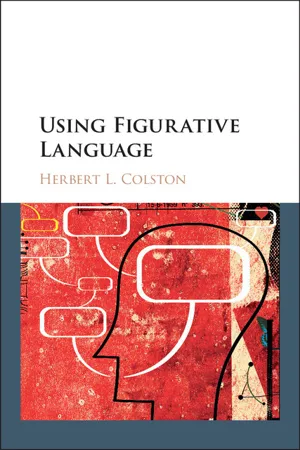Languages & Linguistics
Rhetorical Figures
Rhetorical figures are linguistic devices used to enhance the persuasiveness and impact of communication. They include techniques such as metaphors, similes, and hyperbole, which are employed to create vivid imagery, emphasize key points, and engage the audience. By skillfully incorporating rhetorical figures into language, speakers and writers can effectively convey their message and evoke specific emotions or responses from their audience.
Written by Perlego with AI-assistance
Related key terms
1 of 5
12 Key excerpts on "Rhetorical Figures"
- eBook - ePub
Routledge Revivals: Essays on Style and Language (1966)
Linguistic and Critical Approaches to Literary Style
- Roger Fowler(Author)
- 2017(Publication Date)
- Taylor & Francis(Publisher)
8 Linguistics and the Figures of RhetoricI
IF RHETORIC is an outmoded discipline, its influence lives on in the present-day study of literature at least in the ‘figures of speech’ (above all, metaphor) which form an important part of critical vocabulary. Neither the traditional ‘definitions’ of the rhetorical manuals, nor those of the more recent manuals of usage, provide a satisfactory account of these terms; and attempts to elucidate them by reference to the psychology or philosophy of language have met with only limited success, largely, it seems to me, because of the inadequacy of the linguistic part of the writers’ explanatory equipment. In consequence, the subject of Rhetorical Figures has become an unjustifiably neglected department of literary education.This chapter is not an attempt to provide a practical remedy for this state of affairs, in the form of detailed descriptions of figures of speech. (This last term is used in a loose modern sense, roughly incorporating all that was meant by ‘figures of speech’, ‘tropes’, and ‘figures of thought’ in classical rhetoric.)1 Many of these figures (particularly those which traditionally belong under the heading ‘figures of thought’) appear to lie altogether outside the linguist’s sphere of competency; others do not entirely fall within it. Moreover, a consistent and accurate linguistic account of figures of speech can only be undertaken within the framework of a more general account of the characteristic linguistic features of literary texts. My primary aim, therefore, will be to suggest how linguistic theory can be accommodated to the task of describing such recurrent phenomena in literature as metaphor, parallelism, alliteration and antithesis.Rhetoric only enters into the discussion in so far as it has provided us with most of our terminology for talking about these features. In a historical perspective, the Ars Rhetorica and Ars Poetica - eBook - PDF
- Marie Lund(Author)
- 2017(Publication Date)
- Aarhus University Press(Publisher)
This new material possesses two interchangeable and simultaneous qualities; it makes the food both safe and visible. A rhetorical figure will often be used along with an ex- panded version of the argument which provides the details that back up the central claim made by the figure. It is an important point that the rhetorical figure is the argument in its most condensed form: “In the presence of more text, it could be said, as the old manuals would put it, that the precise phrasing of this figure adds force or vividness to the whole argument. But it also is the argument itself in the most com- pressed form possible. If the text were to be reduced to one sentence, that one sentence, emblematic of the whole, would be the figure.” 33 Fahnestock’s further investigation evolves as a study of primar- ily four Rhetorical Figures which have traditionally been associated with the structural thinking known as reasoning or argumentation: antithesis, incrementum (and gradatio), antimetabole, and ploche (and polyptoton). 34 Some conceptual and methodological perspectives fol- 32 Ibid., 24. 33 Ibid., 25. 34 Fahnestock investigates a larger stylistic territory in Rhetorical Style. The Uses of Language in Persuasion (Oxford: Oxford University Press, 2011). This page is protected by copyright and may not be redistributed. An Argument on Rhetorical Style 74 low from the definition of figures as certain durable lines in the ar- gumentation. When Rhetorical Figures are perceived as epitomes of a longer line of argument, the argumentation may persist even when it is not epitomized in an iconic form. The analytical and critical focus therefore changes from the rigid definition of what figures ‘are’ to a description of their argumentative function. Furthermore, Fahne- stock is not afraid to talk about an argument, for instance antithesis or gradatio, although the figure only appears in half-finished form: But an argument need not be epitomized, need not be ex- pressed succinctly. - eBook - ePub
Rhetorical Argumentation
Principles of Theory and Practice
- Christopher W. Tindale(Author)
- 2004(Publication Date)
- SAGE Publications, Inc(Publisher)
3
…And Rhetoric as Argument
INTRODUCTION: Rhetorical Figures AND ARGUMENTS
The last chapter explored argument as rhetoric. Now we want to turn things around and ask whether rhetoric, or at least traditional rhetorical devices like the figures, can serve as argument. Reboul (1989) raises just this question when he asks: “Can a figure of rhetoric be an argument? Can it be an element of argumentation?” (169). A recent study of Rhetorical Figures in the domain of science by American scholar Fahnestock (1999) suggests a very deep relationship between figures and arguments to the point where figures can be seen to play important argumentative roles. In this chapter, we will look closely at the work of Reboul and Fahnestock, as well as that of Perelman and Olbrechts-Tyteca. In drawing on what these scholars have to say about the place of figures in a theory of argument, we will look to push their proposals a little further. Certainly, there are many ways in which figures contribute to the success of arguments. But we can go further than Fahnestock and show that figures do not just facilitate arguments; in some cases they are arguments. The issue is then whether they work as patterns of argument like other traditional types of argument, and whether they have corresponding conditions that can help us evaluate them. In some cases, we will see that they can.Rhetorical Figures are devices that use words to make some striking effects on an audience. We have already encountered some Rhetorical Figures in this book. Van Eemeren and Houtlosser drew on several figures in their development of rhetorical dimensions within the model of pragma-dialectical argumentation. For example, at each stage of a critical discussion appropriate presentational devices can be exploited by an arguer. Here, Rhetorical Figures are used to impress moves upon the mind, thus compounding their effect. As a case in point, their study of William the Silent’s discourse identifies the figure praeteritio - Meriel Bloor, Thomas Bloor(Authors)
- 2013(Publication Date)
- Routledge(Publisher)
5 Figurative language, metaphor and message5.1 Rhetorical devices in discourseRhetoric … is essentially geared towards the persuasive communication of preferred models of social events, and thus manages how recipients will understand and especially how they will evaluate such events, for instance as a function of the interests of the participants. It is therefore not surprising that rhetorical structures play such an important role in ideological manipulation.(van Dijk, 1998a: 208)This chapter is about the rhetorical devices that speakers and writers use to construct their messages. Public speakers, advertisers, politicians, journalists and others deliberately use this resource knowingly to enhance the way they use language. However, we all – even small children – use some rhetorical devices unconsciously in everyday communication.No doubt most cultures have some type of rhetorical tradition and many have a tradition of commentary and critique as well. Certainly, in the Arab world and in India and South-East Asia as well as China and Japan, traditional approaches to rhetoric are valued and new ones develop. In Ethiopia, there are regions where oratory competitions are traditionally held and judges discuss the various merits of the speakers’ techniques, even referring to the characteristics of highly valued speakers from the past. Similarly in Shona discourse, oratory and oral story telling have a long tradition, and the use of figures of speech and in particular the ideophone (onomatopoeia used to represent sounds, such as the sound of hooves) is incorporated, often with gesture, into the narrative.5.2 Aristotle’s RhetoricThe study of rhetoric dates back though history. In Europe, we attribute the first description of rhetorical devices to classical Greece, where there were schools of rhetoric in which students were taught the art of persuasion and argument, particularly with respect to public speaking. There was a demand for such training because of the power wielded by effective speakers in the assembly, where the enfranchised men of Athens (about 25 per cent of the total population) were free to debate issues of city government and had the scope to create and revise laws as well as to operate them. Isocrates, for example, who first made his living writing speeches for politicians, opened schools of rhetoric in Athens and Chios (by 387 BC ), training orators in the techniques of persuasion, and became a rich man as a result. However, for our purposes in CDA, the most important of the Greek rhetoricians was Aristotle, who opened his own school, the Lyceum, in Athens in the year of Isocrates’ death (338 BC- eBook - PDF
- Joachim Knape, Alan L. Fortuna(Authors)
- 2012(Publication Date)
- De Gruyter(Publisher)
Easy idioms bridge the gaps and comfortable metaphors ease us through the traffic.” 35 Heinrich Lausberg remains silent for a while. He is obviously thinking over Tyler’s point. Then he says, “the fixed idiomatic expressions you mentioned do not belong in my rhetorical thesaurus. They are partially complex – i.e. simply ‘multilexical’ – constructions, but they remain lexicalized expressions of single languages. You could call them formulas or idioms. Like words, they belong in the dictionaries of single languages or dictionaries for particular groups (lawyers, sportsmen, youth etc.). Rhetorical Figures, on the other hand, are constructions which are not restricted to a single language. They follow universal rules of production which are at a minimum valid for the Indo-Ger- manic languages. The rhetorician distinguishes between three kinds of figures: 1. tropes, 2. schemes, and 3. figures of thought. Rhetorical Figures like meta- phor, anaphora and chiasmus can be created in every language, which is why one can also speak of a second, rhetorical grammar. But what should such a grammar look like? The production of rhetorical schemes (a) follows rules of 34 Lausberg 1960, p. xxviii and § 1246, p. 904. 35 Tyler 1987, pp. 105 ff. Language or Rhetoric? A Dialog 85 construction and rhetorical schemes (b) can be recognized due to a fixed struc- ture. For example, the rule of production for the figure ‘chiasmus’ in all lan- guages is, ‘construct two sentences in such a way that they are parallel in syntax, but reverse the order of the corresponding words, the pattern being a mirror inversion at a particular axis’. Its pattern can be represented as follows: abc|cba. Here a few examples: ‘But many that are first shall be last, and the last shall be first’ or ‘when the going gets tough, the tough get going’.” “The important thing is what we do with such Rhetorical Figures,” Stephen Tyler says. - eBook - PDF
- Mike Duncan, Star Medzerian Vanguri(Authors)
- 2013(Publication Date)
- Parlor Press, LLC(Publisher)
As the course progressed, they routinely expressed surprise that they had not learned to assign useful names, whether in Greek, Latin or English, to seemingly ubiquitous phenomena. Indeed, my students were quite open to learning these terms, to puzzling through at times subtle distinctions between related terms, and to discovering new figures not found on venerable lists. They were eager to identify current instances of classical forms and to convince themselves that these rhetorical devices transcended language and era. They learned, for example, that syllepsis —a form of zeugma in which one word governs several others in unrelated senses (e.g., Alexander Pope’s “she stained her honor and her new brocade”)—was Greek in name only. They confirmed 49 Stylistic Sandcastles their ability to invent novel instances of a figure once its form and function were understood. They could identify contexts in which a particular figure might be effective and also those contexts when it was not. Beyond learning individual figures, my students came to realize that the figures constituted an open-ended, yet not arbitrary, set of linguistic moves. It was not long before class discussion gravitated quite naturally to questions of form and meaning. What, exactly, is a figure? When is something not a figure? How do figures work? Are certain figures unique to one language or culture? How many figures are there? Often, then, our efforts to categorize figures and describe their effects would lead to questions that required more than a simple yes or no . Often, we would discover that language is complex enough that several figures might be interacting in a given expression. To achieve these insights on my part and theirs, a range of learning activities beyond introducing, memorizing, and recalling of terms was required. - eBook - PDF
Politics & Rhetoric
Coming to Terms with Terms
- G. Yoos(Author)
- 2009(Publication Date)
- Palgrave Macmillan(Publisher)
The best example I have seen of a visual metaphor was on David Letterman’s nightly show on TV. He had his visiting “zoo friend” bring his odd assortment of unusual animals onto the program. One night it was a two-headed turtle. It was crawling slowly on Letterman’s desk. And each head of the turtle seemed to want to crawl in opposite directions. David Letterman remarked, “It is like marriage.” Rhetorical Figures are traditionally divided up into schemes and tropes. Schemes mostly depend for their effectiveness on alterations in syntax by repeti- tion, by shifting or clarifying references, and by altering presumptions and using ellipses, diversions, and other forms of omission. Such rhetorical strategies are important in helping us understand the elements of eloquence and literary style Figurative and Literal Language 113 that bring meaning into full force and focus and give us clarity about new ways of understanding. They give us new refinements of meaning. But tropes are figures that create new uses of terms by semantic change, by shifts and twists of meaning, and by divided reference that connote different senses of the terms. They often deal with rhetorical condensations and expan- sions of meaning. The most interesting of the tropes I find are metaphor and synecdoche. Both figures deal with the shifting meanings of words by calling something “something” that it is not. Tropes are the stuff of literary style. They make the most of common experiences to express new points of view that the writer can presumptively share with his or her reader. When we define all the tropes or figures we see that their definitions often border on each other. Note how poetic imagery quickly turns to metaphor. We suggest finally that when we are speaking of tropes and figures we are calling attention to processes that deviate from straightforward and normal ways of saying that something is the case. - eBook - PDF
- Timothy Crews Anderson(Author)
- 2021(Publication Date)
- Humanities E-Books(Publisher)
Chapter 4: Rhetorical Devices and Informal Fallacies Not surprisingly, people who wish to convince others to adopt their positions do not always rely solely on attempts to establish sound and cogent arguments. People are often more interested in convincing rather than seeking the truth of the matter. Advertisers, advocates, politicians, political pundits, etc. (the list truly goes on and on) have developed quite an arsenal for levelling arguments or colouring the language of argumentation in such a way as to make the rea-sons for accepting their point of view seem to be much more compelling than they actually are. This need not be intentional; that is, a person’s intent need not be deception to make use of these highly persuasive tactics. Certainly there are many cases in which a devious type will deliberately set out to deceive, but there also many instances in which people in good faith unwittingly make use of them as well. Those who have an interest in identifying attempts at deception as well as those who are interested in compellingly arguing their points in a reason-able manner should take note of what follows. 4.1 Rhetorical Devices A rhetorical device , in general, is a use of language that makes a position seem to be more compelling than it would otherwise be by generating an emotional response . This sort of tactic is especially insidious as it often much easier to manipulate emotions than it is to appeal to reason. Heightened emotions cloud the thinking and often have the effect of masking the fact that emotions have been manipulated in the first place. It is crucial to insightful and critical thought that such manipulation be identified and that a position be dispassionately con -sidered on its merits rather than on emotional responses that have been gener-ated by its proponents or opponents. The following is a brief overview of some rhetorical devices. This list is by no means exhaustive. - eBook - PDF
Advances in the History of Rhetoric
The First Six Years
- Richard Leo Enos, David Beard(Authors)
- 2007(Publication Date)
- Parlor Press, LLC(Publisher)
2 Aristotle has taken his asyndeton from “the end of Lysias, Against Era-tosthenes (12.100): ‘You have listened, you have seen, you have suffered, you have [the fact]. You be the judge’” (Kennedy 282, n. 268). Sara Newman 236 his corpus in prominent places and in roles quite different than the traditional approach to metaphor and to Aristotle’s understanding of this subject allows. 3 According to that traditional wisdom, language is a matter of style and thus accessory to knowledge production. Within this stylistic realm, figurative language may enhance linguistic effects if its individ-ual figures are used with appropriate restraint and in suitable contexts. To clarify and encourage these proper uses, rhetorical treatises have characteristically divided the figures on the basis of form and func-tion. But, because these categories have been applied in an arbitrary manner, they have mattered less than their overall message—that the figures are linguistic afterthoughts (Fahnestock 18 – 20 ). One notable exception lies outside this otherwise exclusive grouping; in contrast to the “other” figures, metaphor has always enjoyed an independent scholarly life and an ascendant theoretical status. In contemporary coinage, then, metaphor can refer either to an “implied comparison” or to “figurative language” more broadly construed. Finally, these at-titudes and their attendant problems owe a considerable debt to Aris-totle’s definition of metaphor in the Poetics and the Rhetoric which is the source of all subsequent metaphorical theories and of metaphor’s purported figural authority (in fact, his broader discussions of figures are the foundation for all subsequent systems of tropes and schemes; see Newman, Chapter Eight). At present, the traditional approach to language and to metaphor has been superceded by others that grant to them epistemic and con-ceptual capacities. - eBook - PDF
The Social Use of Metaphor
Essays on the Anthropology of Rhetoric
- J. David Sapir, J. Christopher Crocker, J. David Sapir, J. Christopher Crocker(Authors)
- 2016(Publication Date)
Insofar as we concentrate on The Social Functions of Rhetorical Forms 53 internal metaphors, we can equate the persuasive and expressive dimensions of tropes. Thus far in examining the social use of metaphor, we have tried to demonstrate the utility of such figures in defining situations so that attitudes are transformed and guidelines for behavior are established. But what of the programmatic capacity of meta-phors, their function as langue through the capacity to form analogies in which a whole range of discrete thises are understood in terms of a series of métonymie thats? The problem with internal metaphors is that they are not systematic, they do not participate in any paradig-matic logical structure, so that analysis of a single figure must be worked out independently of any others, as with our pussy example. And once this has been done, what are the results? One special case has been illuminated, we understand one way in which the members of a society go about coping with one set of problems, but this com-prehension may have no relevance to any other behavioral/epistemo-logica! premises entertained by the society. Surely a culture achieves consistency not by treating things and situations constantly in their own terms, but by signifying the character of their participation in a system. Now, as we said earlier, this is not to deny that anthropologists have been able to demonstrate the social impact of certain analogic systems. But usually they have focused on these analogic sets based on internal metaphors, preeminently those with reference to the human body. Social scientists are far from the only humans to appreciate the sys-tematic, functionally ordered organic analogy for the convincing rhetorical portrayal of social categories. - eBook - PDF
- Herbert L. Colston(Author)
- 2015(Publication Date)
- Cambridge University Press(Publisher)
Creativity also interacts with figurative language and pragmatic effects through the more specific sense of an individual’s internal needs. As dis- cussed in Chapter 4 regarding cathartic conceptualization, figurative lan- guage itself, by supporting the means of creativity for speakers/writers, often enables therapeutic benefits. These are achieved in part through the internal pragmatic effects on speakers that some figures perform. People with a high personal need for creativity also can use figurative language to satisfy their personal drive to create or encounter novelty, unusualness, nonsequitorial or otherwise nonstandard content. New Figures Either by enhancing or tweaking preexisting figures or through relatively new mechanisms, a number of clever construction types might be evolv- ing into new kinds of figurative language. As with the retroactive negation construction, these new figures may be only passing fads. Or they may have more longevity. But they nonetheless have ingredients of figurative or Is Figurative Language Used Up? 173 indirect language – some form of nonveridicality with intended meanings that surpass mere underdeterminedness, a structure that itself may encap- sulate or iconize meaning, accompanying pragmatic effects. Thus they remain candidates for new figures either now or in some possible future retro reawakening. Contextual expressions serve as the central component in several new figure candidates. This could be the result of increased exposure and access to content enabled by Internet surfing and streaming media. Greater overall quantity of content itself, increasingly available to people through broad- cast, movies, podcasts, the Internet and other distribution outlets, also could be a contributing factor. - Michael Rand(Author)
- 2014(Publication Date)
- Gorgias Press(Publisher)
441 C HAPTER 4 – R HETORICAL F IGURES The categories defined below do not possess the same degree of logical coherence that is observable in the three canonical grammatical divisions of phonology, morphology and syntax. Instead, under this heading are gathered all phenomena relevant to the Corpus for which a place has not been defined under these three. Included are all forms of paronomasia, syntactic phenomena not usually treated in discussions of Hebrew syntax, and other features that in a handbook on classical philology would typically have found their place under the heading of “Rhetorical Figures.” It is difficult to observe a logical order when dealing with such an eclectic collection of phenomena, but an attempt has been made to mirror a traditional philological treatment by progressing from those that are primarily morphological, to the syntactic, to the semantic. §27 P ARONOMASIA §27 a Two Words Readable as One ( /1) = ‘I will begin’. This paronomasia was already noted by Shmuel bar Avshalom, author of , a reshut for this qedushta . 714 The last line there is , so that the last word is connected by anadiplosis to the first two words of Qillir’s magen . §27 b Two Words from MT to be Read as One ) ( ‘youth’ ( /46) ) ( -(Ps. 48:15; BHS app . crit ., ad . loc .: “mlt Mss ”; cf. Targ., ad loc .: ). §27 c One Word from MT to be Read as Two 1) ‘in the shadow of the Brilliant One [=God]’ ( /57) ) ( (I Sam. 10:2) 714 Cf. Goldschmidt, , 1.64. G RAMMAR OF H EBREW P OETRY 442 2) ‘the fire of the law’ [=Torah] ( /67; /189) ) ( (Deut. 33:4) 3) ‘generation of knowledge’ [=the Exodus generation] ( /576) ) ( (I Kings 5:11) Notes: The technique of scriptural exegesis whereby one word is read as two is quite old, as might be ascertained by briefly sketching the tradition of interpretation that lies behind the second example. The obscure MT word is already translated by both Aquila and Symmachus as if it were a construct phrase: (Symm.), (Aq.).
Index pages curate the most relevant extracts from our library of academic textbooks. They’ve been created using an in-house natural language model (NLM), each adding context and meaning to key research topics.

